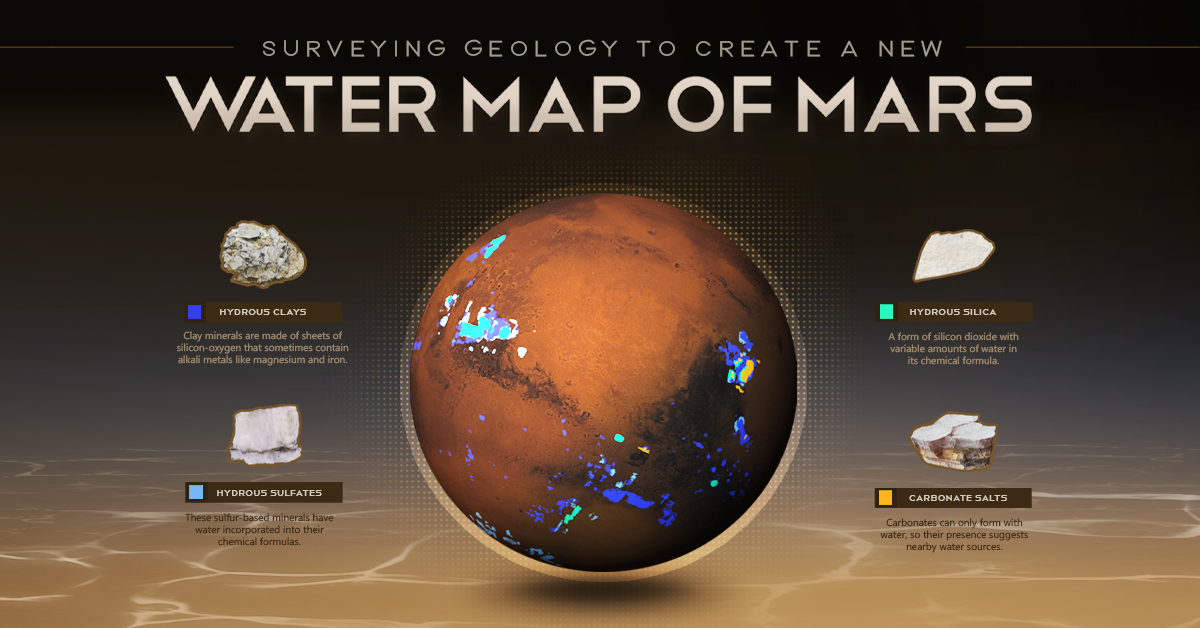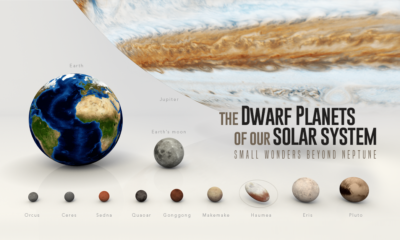Science
Animated Map: Where to Find Water on Mars
Animation: New Water Map of Mars
The hunt for water on Mars has always been a point of interest for researchers.
Earth has life almost everywhere water exists. Water is an ideal target for finding lifeforms, like microbes, that may exist on other planets.
And if Mars is to become a future home, knowing where water exists will be necessary for our survival.
Both NASA and the European Space Agency (ESA) have special instruments searching for water on the red planet. After 10 years of in-depth investigation, their latest findings suggest a new “water map” for Mars.
Where Did the Water Go?
Many people know Mars as a dry and dusty planet, but it hasn’t always been that way.
Approximately 4.1 to 3.8 billion years ago, Mars had a massive ocean called Oceanus Borealis. It dominated the northern hemisphere of the planet. Specific planetary conditions at that time let water exist on its surface. Changes in temperature, climate, and geology over the years gradually pushed water out to the atmosphere or into the ground.
Up to 99% of this ocean water is trapped within the planet’s crust, locked within special rocks called hydrous minerals.
Hydrous Minerals
Hydrous minerals are essentially rocks that have water (or its two main elements, hydrogen and oxygen), incorporated into their chemical structure.
There are four main classes of hydrous minerals: silicates, sulfates, silicas, and carbonates. While these minerals look pretty similar to the naked eye, their chemical compositions and structural arrangements vary. They are detectable by sophisticated equipment and can tell scientists how water geologically changes over time.
The new water map of Mars actually highlights the location of these hydrous minerals. It is a geological map of the rocks that are holding what remains of Mars’s ancient ocean.
Other Sources of Water on Mars
Despite being a “graveyard” for the bulk of the planet’s ocean, hydrous minerals are not the only source of water on Mars.
Water ice is present at both of Mars’s poles. The northern polar ice cap contains the only visible water on the planet, while the southern pole covers its water with a frozen carbon-dioxide cap.
In 2020, radar analyses suggested the presence of liquid water, potentially part of a network of underground saltwater lakes, close to the southern pole. In 2022, new evidence for this liquid water suggested that the planet may still be geothermally active.
More frozen water may be locked away in the deep subsurface, far below what current surveying equipment is able to inspect.
Mapping Out the Next Missions
The new water map is highlighting areas of interest for future exploration on Mars.
There is a small chance that hydrous minerals may be actively forming near water sources. Finding where they co-exist with known areas of buried frozen water provides possible opportunities for extracting water.
ESA’s Rosalind Franklin Rover will land in Oxia Planum, a region rich in hydrous clays, to investigate how water shaped the region and whether life once began on Mars.
Many more investigations and studies are developing, but for now, scientists are just getting their toes wet as they explore what hydrous minerals can tell us of Mars’s watery past.
Misc
Infographic: Investment Opportunities in Biotech
Capture the investment opportunities in biotech with the MSCI Life Sciences Indexes, which target areas like virology and oncology.

Infographic: Investment Opportunities in Biotech
With the world evolving at an unprecedented pace, nearly every sector is being disrupted in some way or another.
In transportation, EVs were spearheaded by Tesla, which emerged as the first new American automaker in decades, and is now one of the world’s most valuable companies. Similarly, in the realm of AI, OpenAI has taken a leading position in large language models, demonstrating the immense potential of the technology.
Now, we turn our attention to biotech, an industry that is developing innovative treatments at an accelerated pace. In this graphic from sponsor MSCI, we explain the growing pipeline of biotech treatments, and why this could benefit investors.
Growth in Clinical Drug Trials
A clinical drug trial is a study performed on people to evaluate the effectiveness of a medical intervention. Since 2000, the number of trials initiated annually has grown by over 1,300%.
| Drug Trial Type | 2000 | 2010 | 2020 | 2022 |
|---|---|---|---|---|
| Monoclonal antibody | 60 | 623 | 1,833 | 1,685 |
| Protein & peptide therapeutics | 172 | 1,058 | 1,771 | 1,567 |
| Vaccine | 80 | 594 | 1,259 | 915 |
| Recombinant antibody | 50 | 513 | 984 | 860 |
| Cell therapy | 56 | 277 | 548 | 502 |
| Gene-Modified Cell Therapy | 16 | 148 | 355 | 423 |
| DNA & RNA therapeutics | 7 | 56 | 475 | 346 |
| Other biotechnology product | 28 | 236 | 362 | 347 |
| Total | 469 | 3,505 | 7,587 | 6,645 |
Behind every new treatment is an innovative company working to develop it. Thus, as the number of clinical trials grows, so too does the size of the investment universe.
Unfortunately, identifying suitable companies for investment is rather difficult. While a disease may have thousands of potential medicines, only one may ultimately receive FDA approval. This approval process can also take over a decade because treatments must pass several phases of testing.
Introducing the MSCI Life Sciences Indexes
To capture investment opportunities in biotech, MSCI has released a suite of thematic indexes that focus on key growth categories such as oncology and virology.
Developed in collaboration with Royalty Pharma, the world’s largest buyer of pharmaceutical royalties, the MSCI Life Sciences Indexes are designed to gauge the performance of pioneering companies within the biotech space.
These unique indexes can be used to benchmark growth, facilitate portfolio construction, and enhance investment research.

Explore the MSCI Life Sciences Indexes now

-

 Politics18 hours ago
Politics18 hours agoHow Do Chinese Citizens Feel About Other Countries?
What is the Chinese public’s view of world powers? This visual breaks down Chinese sentiment towards other countries.
-

 Maps7 days ago
Maps7 days agoMapped: The Safest Cities in the U.S.
How safe is small town America? This map reveals the safest cities in the U.S. in terms of the total crime rate per every 1,000 residents.
-

 Countries7 days ago
Countries7 days agoMapped: World’s Top 40 Largest Military Budgets
War in Europe has caused Ukraine’s military spend to jump up by 640%. How do the world’s largest military budgets compare?
-

 United States1 week ago
United States1 week agoMapped: The Most Dangerous Cities in the U.S.
This map shows the most dangerous cities in the U.S. in terms of the violent crime rate per 1,000 residents.
-

 History2 weeks ago
History2 weeks agoVintage Viz: The World’s Rivers and Lakes, Organized Neatly
Rivers and lakes have played important roles throughout history. This Vintage Viz looks at these bodies of water from the viewpoint of 1850.
-

 Business1 month ago
Business1 month agoVisualizing Annual Working Hours in OECD Countries
Where do people work the most? Explore our analysis of the average annual working hours across OECD countries.
-

 Markets3 weeks ago
Markets3 weeks agoHow Big is the Market for Crude Oil?
-

 Maps7 days ago
Maps7 days agoMapped: The Safest Cities in the U.S.
-

 Markets2 weeks ago
Markets2 weeks agoRanked: The Most Profitable U.S. Companies, by Sector
-

 apps5 days ago
apps5 days agoHow Long it Took for Popular Apps to Reach 100 Million Users
-

 Markets4 weeks ago
Markets4 weeks agoThe World’s Biggest Mutual Fund and ETF Providers
-

 Brands2 weeks ago
Brands2 weeks agoBrand Reputations: Ranking the Best and Worst in 2023
-

 Environment5 days ago
Environment5 days agoHotter Than Ever: 2023 Sets New Global Temperature Records
-

 Datastream4 weeks ago
Datastream4 weeks agoCan You Calculate Your Daily Carbon Footprint?


















